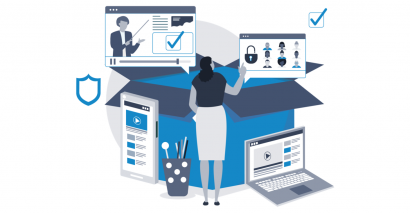The safeguarding of every student in your school's care is the responsibility of all your staff. To best protect your students, everyone needs to understand their specific caring responsibilities and how they need to work in partnership with others to promote the best interests of children and young people.
But what are the current biggest safeguarding challenges and how can staff identify and deal with them? Here are seven key concerns that staff should be aware of right now.
1. Child sexual abuse material (CSAM)
Children and young people have been brought up with the internet and being online enables them to socialise, learn and experience many things in a variety of different ways.
But, as we all know, there are dangers associated with everyday internet use. Child sexual abuse material (CSAM) is commonplace and can be found on mainstream social media and online gaming platforms. In 2021 there were 85 million pictures and videos depicting child sexual abuse reported worldwide*. Many more will have gone unreported.
It's vital that everyone working with children and young people:
- Is aware of risks online
- Has appropriate online safety training
- Works with and learns from children and young people about what they’re doing online
- Makes sure that any technology used is used appropriately
- Ensures children have appropriate routes to support and reporting
2. Child-on-child sexual violence and harassment
In 2021 Girlguiding released figures stating that of their members, two thirds of girls and young women experienced sexual harassment in school. It’s vitally important to understand that it can happen anywhere, and you should maintain an attitude that it could already be taking place in your school.
All reports and concerns must be taken seriously, and your school should operate a zero-tolerance policy on this kind of behaviour, be it verbal or physical. Downplaying these incidents will foster an environment in which children won’t feel safe or comfortable enough to report abuse.
3. Extremism and radicalisation
Children and young people are particularly vulnerable to radicalisation. Adolescence is a time of social and self-exploration, and for some young people, extreme groups and worldviews can be appealing. What may begin as genuine curiosity may lead to a process of radicalisation conducted by older, manipulative extremists.
Risk factors for being radicalised include:
- Social isolation
- Precarious emotional ties
- Radical or otherwise violent peers or significant others
- A lack of positive role models and critical thinking space
- Impulsivity
- Difficult or tragic life events
- Intolerance towards ambiguity
- The feeling of being culturally or politically alienated
- Significant time spent online
All safeguarding policies should have clear procedures in place for protecting children at risk of radicalisation.
4. Domestic abuse
Every day, children and young people experience domestic abuse at home and can suffer a wide range of severe and long-lasting effects. Witnessing domestic violence can have a profound direct and/or indirect impact on children and young people. In some cases, a child may blame themselves for the abuse or may have had to leave the family home as a result.
You should always follow your school’s child protection policy if you suspect children are witnessing and/or experiencing domestic abuse, and if you suspect a child is in danger, contact the police.
5. Adverse childhood experiences
What a child experiences, is fundamental to their mental health and emotional wellbeing in childhood, adolescence and adulthood. Adverse childhood experiences (ACEs) is the term used to describe highly stressful and potentially traumatic events or situations that occur during childhood or adolescence.
A child or young person that suffers a traumatic event may not be able or want to tell you what they’re feeling. Their voice can often be lost in adults making all the decisions for them. They may feel and exhibit a range of emotions including, fear, sadness, anger, guilt, shame and have no control of what’s happening.
6. Trauma-informed practice
Trauma can be defined as any single, multiple, ongoing, or cumulative experience which:
- Is a response to a perceived threat (even after the traumatic experience has passed)
- Overwhelms our capacity to cope
- Feels or is outside our control
- Evokes a physiological and psychological set of responses based on fear or avoidance
Trauma affects all aspects of a child’s development including the brain, body, emotions, memory, relationships, learning and behaviour.
Schools are unique environments with wonderful opportunities to offer trauma responsive provisions to children; from building a safe and predictable environment to implementing a relationship policy to ensure staff interact with children with kindness and compassion.
7. Mental health
The wellbeing of young people is a key concern for anyone entering education, and the need for children to have a happy and well-rounded experience should be at the heart of every schools’ ethos. Enjoying good relationships and being able to deal with setbacks also helps to preserve mental wellbeing and builds resilience.
A whole-school approach to wellbeing is key and all staff should be given training on the most common issues, including:
- Anxiety
- Low mood and depression
- Self-harm
- Conduct disorders
For more information download our free guide 7 key safeguarding concerns for schools right now to ensure that all your staff have the essential information they need to protect all your students.
To keep all your staff up to date with the latest training in safeguarding, compliance, health and safety, and wellbeing take a look at our whole-school online training package, Tes Safeguarding.





